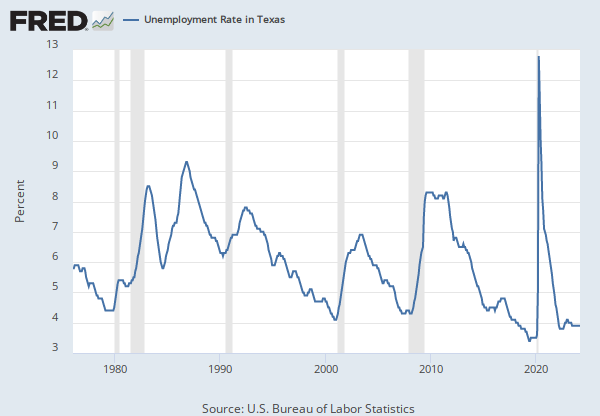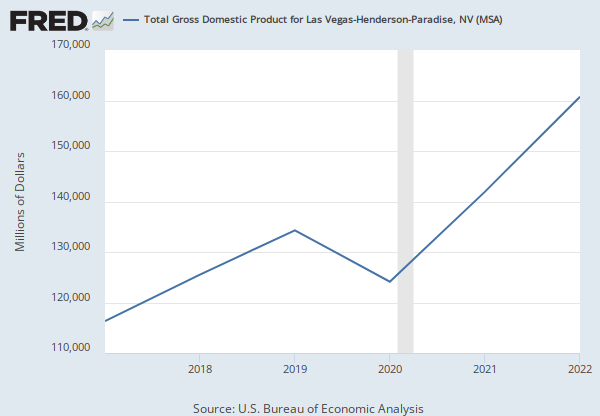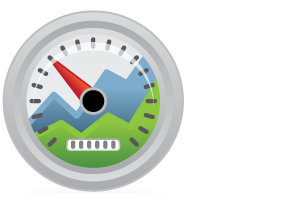Federal Reserve Economic Data: Your trusted data source since 1991
Data in this graph are copyrighted. Please review the copyright information in the series notes before sharing.
NOTES
Source: U.S. Bureau of Labor Statistics
Release: State Employment and Unemployment
Units: Percent, Seasonally Adjusted
Frequency: Monthly
Suggested Citation:
U.S. Bureau of Labor Statistics, Unemployment Rate in Florida [FLUR], retrieved from FRED, Federal Reserve Bank of St. Louis; https://fred.stlouisfed.org/series/FLUR, June 5, 2024.
Source: U.S. Bureau of Labor Statistics
Release: Employment Situation
Units: Percent, Seasonally Adjusted
Frequency: Monthly
Notes:
The unemployment rate represents the number of unemployed as a percentage of the labor force. Labor force data are restricted to people 16 years of age and older, who currently reside in 1 of the 50 states or the District of Columbia, who do not reside in institutions (e.g., penal and mental facilities, homes for the aged), and who are not on active duty in the Armed Forces.
This rate is also defined as the U-3 measure of labor underutilization.
The series comes from the 'Current Population Survey (Household Survey)'
The source code is: LNS14000000
Suggested Citation:
U.S. Bureau of Labor Statistics, Unemployment Rate [UNRATE], retrieved from FRED, Federal Reserve Bank of St. Louis; https://fred.stlouisfed.org/series/UNRATE, June 5, 2024.
Source: U.S. Bureau of Labor Statistics
Release: State Employment and Unemployment
Units: Percent, Seasonally Adjusted
Frequency: Monthly
Suggested Citation:
U.S. Bureau of Labor Statistics, Unemployment Rate in Louisiana [LAUR], retrieved from FRED, Federal Reserve Bank of St. Louis; https://fred.stlouisfed.org/series/LAUR, June 5, 2024.
Source: U.S. Bureau of Labor Statistics
Release: Unemployment in States and Local Areas (all other areas)
Units: Percent, Not Seasonally Adjusted
Frequency: Monthly
Notes:
These data come from the Current Population Survey (CPS), also known as the household survey.
Civilian Labor Force includes all persons in the civilian noninstitutional population ages 16 and older classified as either employed or unemployed.
Employed persons are all persons who, during the reference week (the week including the 12th day of the month), (a) did any work as paid employees, worked in their own business or profession or on their own farm, or worked 15 hours or more as unpaid workers in an enterprise operated by a member of their family, or (b) were not working but who had jobs from which they were temporarily absent because of vacation, illness, bad weather, childcare problems, maternity or paternity leave, labor-management dispute, job training, or other family or personal reasons, whether or not they were paid for the time off or were seeking other jobs. Each employed person is counted only once, even if he or she holds more than one job.
Unemployed persons are all persons who had no employment during the reference week, were available for work, except for temporary illness, and had made specific efforts to find employment some time during the 4 week-period ending with the reference week. Persons who were waiting to be recalled to a job from which they had been laid off need not have been looking for work to be classified as unemployed.
The unemployment rate is the unemployed percent of the civilian labor force [100 times (unemployed/civilian labor force)].
For more details, see the release's frequently asked questions.
Suggested Citation:
U.S. Bureau of Labor Statistics, Unemployment Rate in San Bernardino County, CA [CASANB1URN], retrieved from FRED, Federal Reserve Bank of St. Louis; https://fred.stlouisfed.org/series/CASANB1URN, June 5, 2024.
Source: Organization for Economic Co-operation and Development
Release: Main Economic Indicators
Units: Percent, Seasonally Adjusted
Frequency: Monthly
Notes:
OECD Data Filters:
REF_AREA: CAN
MEASURE: UNE_LF_M
UNIT_MEASURE: PT_LF_SUB
TRANSFORMATION: _Z
ADJUSTMENT: Y
SEX: _T
AGE: Y_GE15
ACTIVITY: _Z
FREQ: M
All OECD data should be cited as follows: OECD (year), (dataset name), (data source) DOI or https://data-explorer.oecd.org/. (accessed on (date)).
Suggested Citation:
Organization for Economic Co-operation and Development, Infra-Annual Labor Statistics: Monthly Unemployment Rate Total: 15 Years or over for Canada [LRHUTTTTCAM156S], retrieved from FRED, Federal Reserve Bank of St. Louis; https://fred.stlouisfed.org/series/LRHUTTTTCAM156S, June 5, 2024.
Source: U.S. Bureau of Labor Statistics
Release: State Employment and Unemployment
Units: Percent, Seasonally Adjusted
Frequency: Monthly
Suggested Citation:
U.S. Bureau of Labor Statistics, Unemployment Rate in Texas [TXUR], retrieved from FRED, Federal Reserve Bank of St. Louis; https://fred.stlouisfed.org/series/TXUR, June 5, 2024.
Source: U.S. Bureau of Labor Statistics
Release: Metropolitan Area Employment and Unemployment
Units: Percent, Not Seasonally Adjusted
Frequency: Monthly
Suggested Citation:
U.S. Bureau of Labor Statistics, Unemployment Rate in Detroit-Warren-Dearborn, MI (MSA) [DETR826URN], retrieved from FRED, Federal Reserve Bank of St. Louis; https://fred.stlouisfed.org/series/DETR826URN, June 5, 2024.
Source: U.S. Bureau of Labor Statistics
Release: Metropolitan Area Employment and Unemployment
Units: Percent, Not Seasonally Adjusted
Frequency: Monthly
Suggested Citation:
U.S. Bureau of Labor Statistics, Unemployment Rate in Las Vegas-Henderson-Paradise, NV (MSA) [LASV832URN], retrieved from FRED, Federal Reserve Bank of St. Louis; https://fred.stlouisfed.org/series/LASV832URN, June 5, 2024.
Source: U.S. Bureau of Labor Statistics
Release: State Employment and Unemployment
Units: Percent, Seasonally Adjusted
Frequency: Monthly
Suggested Citation:
U.S. Bureau of Labor Statistics, Unemployment Rate in Alabama [ALUR], retrieved from FRED, Federal Reserve Bank of St. Louis; https://fred.stlouisfed.org/series/ALUR, June 5, 2024.
RELEASE TABLES
- Monthly, Seasonally Adjusted (population data is not adjusted for seasonal variation; not seasonally adjusted version used)
- Table A-10. Selected unemployment indicators, Seasonally adjusted: Monthly, Unemployment Rates
- Table A-15. Alternative measures of labor underutilization: Monthly, Seasonally Adjusted
- Unemployment Rate by Metropolitan Statistical Area, Monthly, Not Seasonally Adjusted: Michigan
- Unemployment Rate by Metropolitan Statistical Area, Monthly, Not Seasonally Adjusted: Nevada
RELATED DATA AND CONTENT
Data Suggestions Based On Your Search
Content Suggestions
Other Formats
Unemployment Rate in Florida
Annual, Not Seasonally Adjusted Monthly, Not Seasonally AdjustedUnemployment Rate
Monthly, Not Seasonally AdjustedUnemployment Rate in Louisiana
Annual, Not Seasonally Adjusted Monthly, Not Seasonally AdjustedUnemployment Rate in San Bernardino County, CA
Annual, Not Seasonally AdjustedInfra-Annual Labor Statistics: Monthly Unemployment Rate Total: 15 Years or over for Canada
Annual, Not Seasonally Adjusted Annual, Seasonally Adjusted Monthly, Not Seasonally Adjusted Quarterly, Not Seasonally Adjusted Quarterly, Seasonally AdjustedUnemployment Rate in Texas
Annual, Not Seasonally Adjusted Monthly, Not Seasonally AdjustedUnemployment Rate in Detroit-Warren-Dearborn, MI (MSA)
Annual, Not Seasonally Adjusted Monthly, Seasonally Adjusted Monthly, Smoothed Seasonally AdjustedUnemployment Rate in Las Vegas-Henderson-Paradise, NV (MSA)
Annual, Not Seasonally Adjusted Monthly, Smoothed Seasonally AdjustedUnemployment Rate in Alabama
Annual, Not Seasonally Adjusted Monthly, Not Seasonally Adjusted





























































































